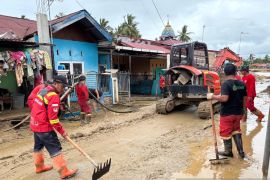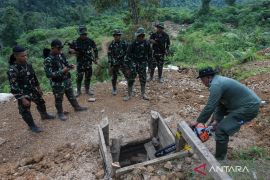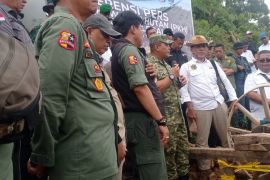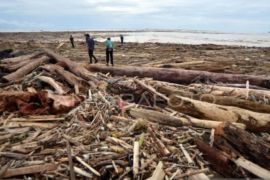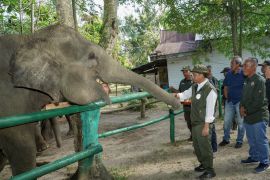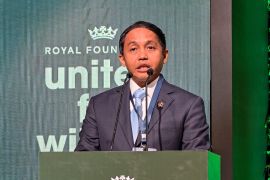The forestry ministry`s data obtained from NOAA Satellite 18, showed that there were 22,120 hot spots throughout Indonesia from January to September 12, 2011.
The hot spots have been found among others in West Kalimantan (4,105 hot spots), Riau (3,208), South Sumatra (3,340), Central Kalimantan (2,778), Jambi (1,305), and North Sumatra (795).
Last year, there were a total of 9,880 hot spots in Indonesia, including 1,785 hot spots in West Kalimantan, 1,707 in Riau, 1,481 in South Sumatra, 831 Central Kalimantan, 603 in Jambi, and 530 in North Sumatra.
In dry season, which usually begins in July until October, some parts of Indonesia are prone to forest and peatlands fires.
The government has planned to reduce the number of hot spots by 20 percent per year to meet the country`s pledge to cut its CO2 emissions by 26 percent by 2020.
The greenhouse gas emission cut pledge was announced by President Susilo Bambang Yudhoyono in his speech to G20 leaders on Sept. 25, 2009. He said the government was crafting a policy that would cut emissions by 26 percent by 2020 from "business as usual" (BAU) levels. With international support, he said he was confident Indonesia could cut emissions by as much as 41 percent.
"This target is entirely achievable because most of our emissions come from forest-related issues, such as forest fires and deforestation," he said in the U.S city of Pittsburgh.
Indonesia has about 130 million hectares of forest area, the world`s third largest after Brazil and Congo.
The country, however, is also considered as one of the largest greenhouse gas emitters mainly through loss of rainforests and forest fires.
To tackle the ongoing forest fires, the forestry ministry has mobilized fire brigade team and three planes to Sumatra Island, where approximately 2,000 hot spots were detected, including in South Sumatra, Jambi and Riau.
Forestry Minister Zulkifli Hasan said in Jakarta recently the planes were needed for cloud seeding because many of the fire hot spots were not accessible as they were located in remote areas.
"There are 2,000 hot spots in Sumatra alone. The forest fires, however, have caused haze disturbing the people and air traffic," he said after launching an online monitoring of one billion tree planting program.
He criticized people who habitually cleared land by igniting fires because they consider it as being the cheapest way of doing it.
Of the country`s total number of hot spots, around 80 percent occurred in agricultural areas and only 20 percent in forests, he said.
"Most of the hot spots are located in agricultural areas, only 10 percent is to be found in forest areas," he said.
Rofi Munawar, a lawmaker, has warned that the ongoing peat forest fires on Sumatra and Kalimantan Islands may cause Indonesia to miss its carbon emission reduction target.
"The peat forest fires will make it difficult for Indonesia to achieve the target of cutting carbon emissions by 26 percent by 2020 as pledged by President Susilo Bambang Yudhoyono, if the government does not pay serious attention to the problem," Rofi Munawar, a member of the House of Representatives (DPR)`s Commission IV, said in Jakarta recently.
Peatlands fires must not be regarded a simple problem because it has affected the community and produced a large volume of carbon dioxide gases because peat contains large carbon reserves, he said.
Indonesia has around 18 million hectares of peatlands, placing the country as the world`s fourth largest peatlands nation after Canada, Russia and the United States. West Kalimantan has 4.61 million ha of peatlands, Central Kalimantan 2.16 million ha, Riau 1.70 million ha, and South Kalimantan 1.48 million ha.
The legislator urged President Susilo Bambang Yudhoyono to instruct affected regional authorities and the forestry ministry to deal with the fires seriously.
He said the government must carry out preventive measures and impose legal enforcement to stop forest fires.
The forestry ministry`s Forestry Protection and Nature Conservation Director General (PHKA) Darori in Jakarta on September 7, 2011, said that the country had successfully reduced the number of forest fires over the past three years.
This year, the government has anticipated forest fires by among other things allocating funds amounting to about Rp160 billion to tackle forest fires in ten provinces.
In general, fires in peat land area were set intentionally. "The fires are due to illegal logging, plantations, and land clearing for agriculture purposes," he said.
The government has emphasized preventive measures by urging the community not to use fire as land clearing methods, the director general said.
According to the recent data of the Riau Meteorology, Climatology and Geophysics Agency (BMKG), the number of hot spots on Sumatra Island has been increasing rapidly to 381 locations.
The Riau BMKG analyst, Warih Puji Lestari said in Pekanbaru, Riau Province, on Saturday (Sept 17), that most of the hot spots monitored by the US National Oceanic and Atmospheric Administration (NOAA) Weather Satellite 18, were located in South Sumatra, where the number reached 179 spots.
The high frequency of hot spots in most of Sumatra provinces, especially in Riau, was caused by the rather hot weather causing dryness in a number of areas especially where they are many mangrove forests or high wild grass, Warih said.
"This condition should not become worse by land fires as it will make the climate and air hotter and dryness will become more serious," Warih said.
The weather analyst predicted that the number of hot spots may increase as the hot season is still in a transition or turn of the tide from the dry to the wet season. (*)
H-NG/F001/S012
Reporter: Ffardah
Editor: Jafar M Sidik
Copyright © ANTARA 2011
